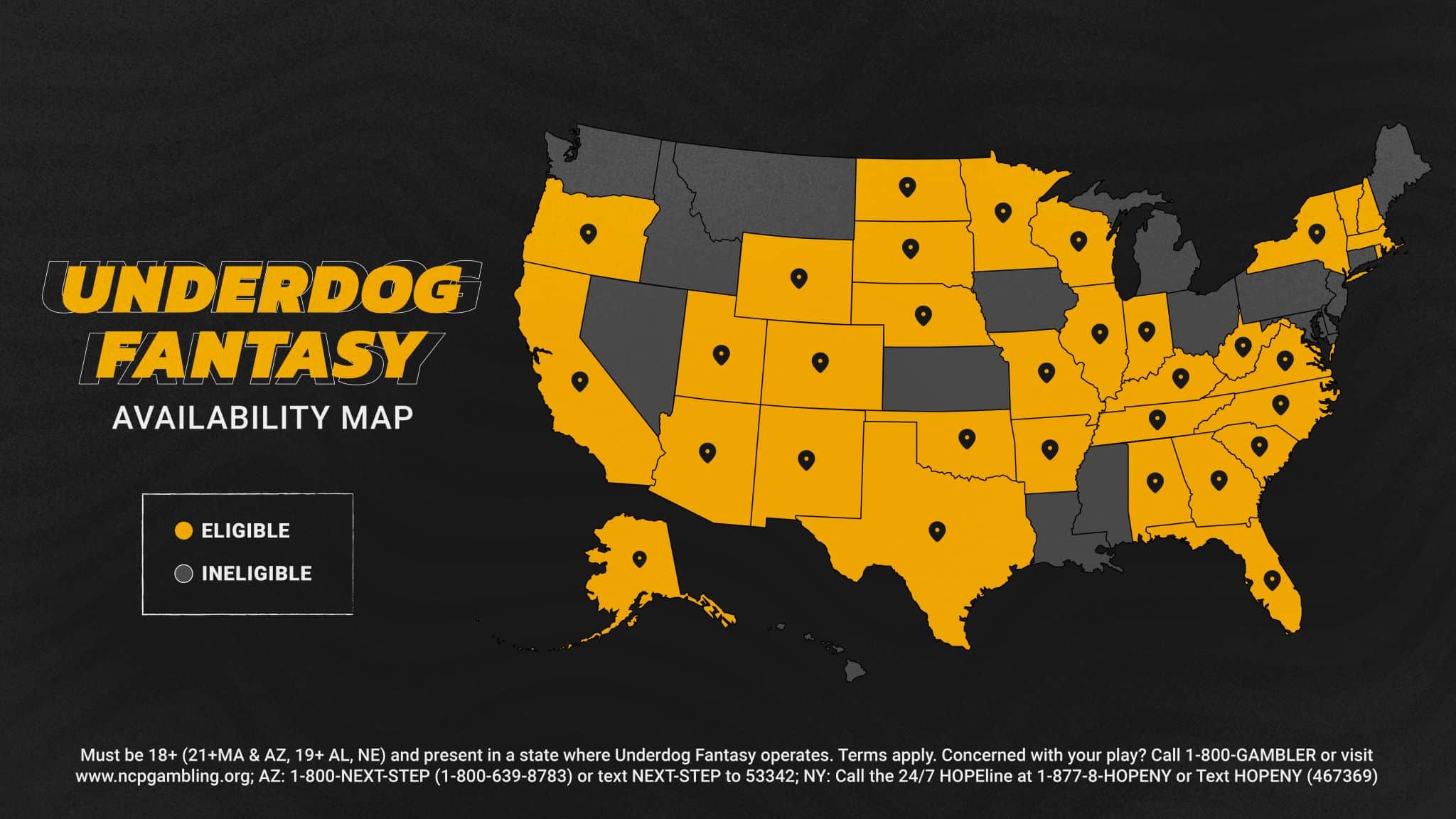Gambling
2024 3M Open Preview
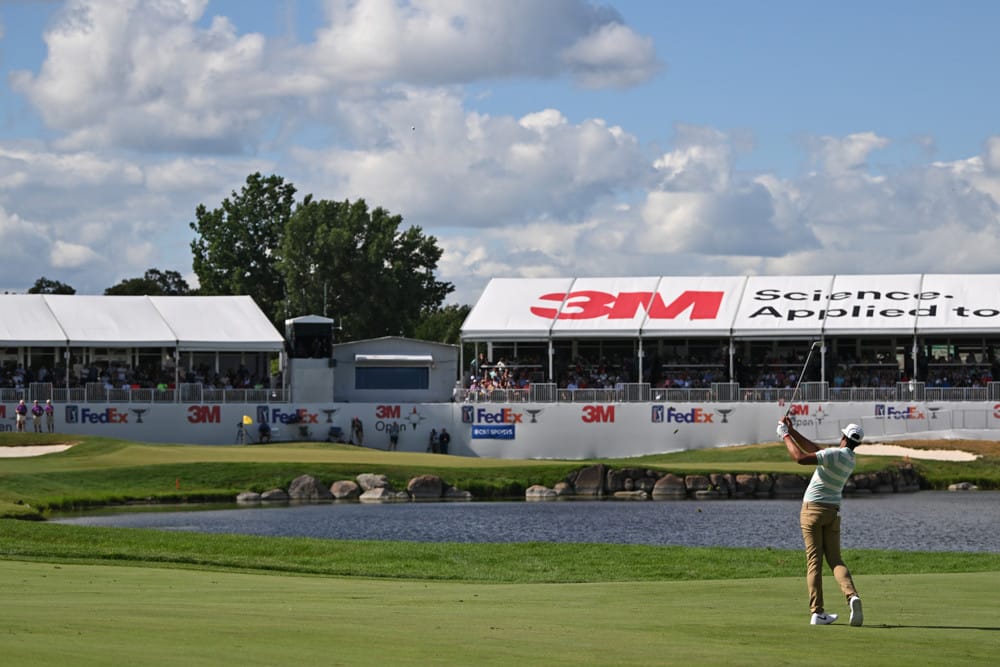
After a thrilling conclusion to the 2024 major championship season, the PGA Tour begins its final stretch toward the FedEx Cup Playoffs. The PGA Tour heads to the Land of 1000 Lakes for the 2024 3M Open at TPC Twin Cities. As always, here is your early preview of the 2024 3M Open and a breakdown of what things to look for before betting the tournament.
Go here for more Golf content!
2024 3M Open Preview
The Golf Course
TPC Twin Cities opened in 2000. It was designed by Arnold Palmer with consultation from Tom Lehman, Minnesota’s favorite golfer. The property was once a sod farm, and Palmer and Lehman transformed it into the current 18 hole layout. The greens at TPC Twin Cities are bentgrass.
They also run about 12 on the stimpmeter (slightly faster than average) and don’t have very complex undulation to them. This golf course was the site of a Champions Tour event before making its way onto the PGA Tour. In 2019, it replaced the Greenbrier on the schedule.
Let me first start by saying something nice about TPC Twin Cities. Like almost all golf courses in the TPC network, it is in immaculate condition.
The greens are also in excellent shape. There are no dead spots in the fairways or rough, and the bunkers are smoothly raked with soft sand. Though TPC golf courses can be a bit of a burden on the wallet, one can expect fantastic course conditions for the amount of money someone forks over for a round or a membership.
That said, TPC Twin Cities is one of the weaker golf course designs on the PGA Tour. When the architects decided how they wanted to challenge players, they defaulted to creating large manmade lakes over and over.
If EA Sports gave an 11-year-old a two-liter of Mountain Dew and asked them to design a custom golf course for one of the PGA 2K video games, the output would be TPC Twin Cities. “Oooooo, let’s put a water hazard here! Let’s also put a bunker here! And look, here’s another giant water hazard over here. Can I also put the Metrodome in the middle of the 12th fairway?”
This golf course is a complete overindulgence of hazards. They built the golf course as an homage to the state of Minnesota’s slogan “Land of 1000 Lakes” There’s absolutely nothing natural about the golf course itself. Don’t believe me? Here’s what the property looked like before they broke ground.
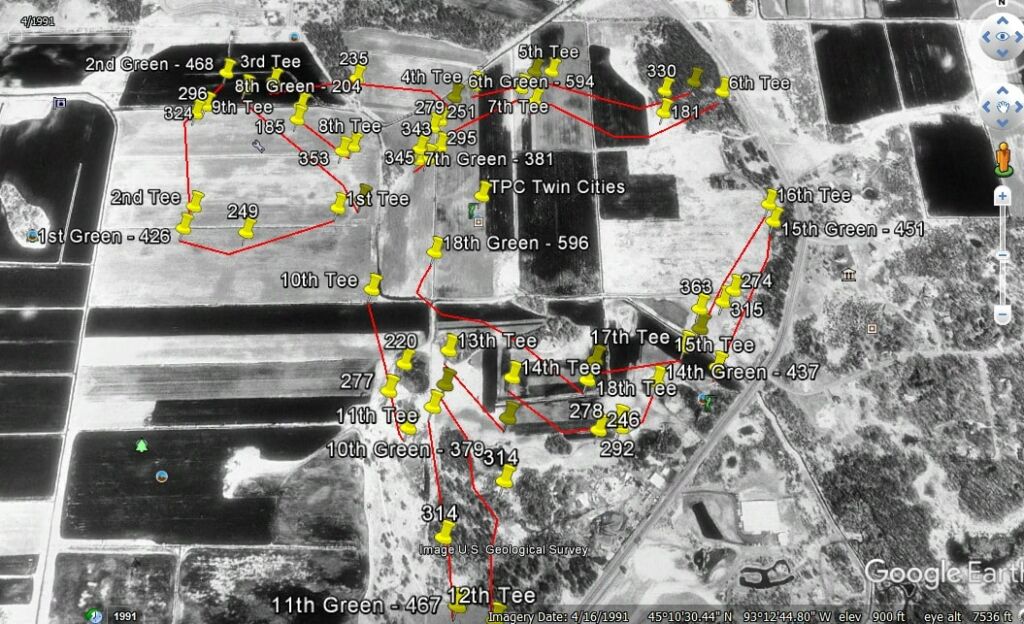
TPC Twin Cities was an old sod farm.
In all, 12 of 18 holes on the golf course bring water into play off the tee or on the approach shot. There’s nothing wrong with strategically placed water hazards or bunkers to challenge players. But the manner in which they’re placed at TPC Twin Cities seems with more of the intention of showing off and peacocking instead of placing them in a strategic fashion.
I’m sure the good folks of Minneapolis are proud of this golf course. It’s in great shape. They also probably take pride in how tough it is on us mere mortals. But just because a golf course is “tough” doesn’t mean it’s good. If you’re reading this and are a mid-to-high handicapper, you probably would be pretty hard-pressed just to break 90 with all the water on nearly every hole.
Who really wants to sign up for that while also forking up a ton of money for a private membership there and knowing you could lose an entire box of Titlist Pro V1’s anytime you play 18.
And despite all the water, TPC Twin Cities hasn’t provided a strong test for the best players in the world. As described below, TPC Twin Cities yields some of the lowest scores on the schedule annually. Despite narrow fairways, modern golf equipment allows players to hit drivers longer and straighter than ever before.
And players have learned, particularly on the Par 5 18th, to use tournament infrastructure to their advantage. Instead of taking on a risky pin position with water close to the green, they’ll overclub and use the grandstands as a backboard knowing they’ll get a free drop for an easy up and down.
With all that said, the 2019 3M Open delivered one of the most exciting finishes on the PGA Tour:
Since the PGA Tour came to TPC Twin Cities, the golf course has been altered a bit. A few new bunkers were added to the driving zones for players. Fairways were also shrunk in width. Somehow, a horrible and unfriendly design for amateurs got even worse for amateur golfers.
Betting Strategies
Here is some general information about Detroit Golf Club. This will assist in optimizing betting strategies for the 2024 Rocket Mortgage Classic.
Par: 71
Length: 7,451 Yards
Despite the stated yardage, DataGolf estimates that the true yardage of TPC Twin Cities (using measured ShotLink data) is only about 7,200 yards. Players shorten up the golf course by hitting over doglegs and water hazards that were designed to force amateur golfers to play around it. It plays much shorter for the PGA Tour.
Architect: Arnold Palmer (2000)
Average Green Size: 6,500 sq. feet
The greens are slightly larger than PGA Tour average.
Agronomy:
- Fairways: Bentgrass
- Rough: Bluegrass/Fescue – ~4″ in length
- Collars & Approaches: Bentgrass
- Greens: Bentgrass (~12.5 on stimpmeter)
Scoring at TPC Twin Cities
- 2023: -1.36
- 2022: +0.13
- 2021: -0.59
- 2020: -1.45
- 2019: -1.76
The difficulty of TPC Twin Cities has varied over the years. In years when the golf course received a lot of wind, such as 2021 and 2022, it showed a little teeth. Despite that, the winning scores in each of those years still crept into the mid to upper teens under par.
But when the winds lay down and the golf course plays soft, like in the other three editions of the 3M Open, the golf course is relatively defenseless and one of the easier golf courses on the PGA Tour. If players avoid the water, then they can rack up lots of birdies in their round.
Off The Tee
Of the 91 golf courses played on the PGA Tour since 2015, TPC Twin Cities ranks 52nd in difficulty off-the-tee.
There isn’t a lot of critical analysis behind how to handicap how this tournament operates off-the-tee. The goal is simple – avoid water. TPC Twin Cities has one of the highest rates of penalties incurred off-the-tee because of the numerous water hazards off the fairway. It ranks 9th on the PGA Tour since 2015 in penalties incurred on tee shots.
For those who do, however, there isn’t a lot of other adversity. The difference in scores on a hole from tee shots that find the fairway and find the rough is only about 0.25 strokes. That’s one of the lower penalties on the PGA Tour. Despite 4 inch ryegrass rough, the holes don’t play difficult enough to make a material difference on one’s score on a hole.
And despite the abundance of water on holes, players aren’t scared of them enough to keep driver in the bag. Since 2019, the average driving distance on all drives at TPC Twin Cities is 292.5 yards. It’s annually one of the longer golf courses on the PGA Tour in terms of average yards per drive.
Considering this is one of the weaker fields on the schedule, which usually comprise shorter hitters who struggle to keep their cards on the PGA Tour, this event would see even higher driving averages if the top echelon of players on the tour played this event.
In summary, pick players who drive the ball well and are able to avoid the water. Great advice. What’s next, bet on football teams who score a lot of touchdowns? But that’s the objective to picking the best golfers to fill out the betting card this week.
There’s no secret sauce behind this tournament in terms of how to properly bet players in terms of how they’ll do off the tee at TPC Twin Cities.
Approach
Of the 91 golf courses played on the PGA Tour since 2015, TPC Twin Cities ranks 71st in approach shots.
What’s shocking about this ranking is that there is a lot of water around the green at TPC Twin Cities. Water comes into play on the approach shot on 8 of 18 holes. Typically, bringing water into play a lot in a round juices up the estimated difficulty on the approach shots in DataGolf’s metrics.
And yet, it still plays incredibly easy. The average green in regulation rate at TPC Twin Cities is 72.2%, which is one of the higher rates on the PGA Tour schedule. Players are provided huge, soft targets into uninteresting greens over and over in their rounds. The modern professional golfer is too good not to be able to take advantage of these conditions.
Here are the proximity buckets for approach shots from the 2023 3M Open. This will preview the types of shots players are required to hit at the 2024 3M Open:
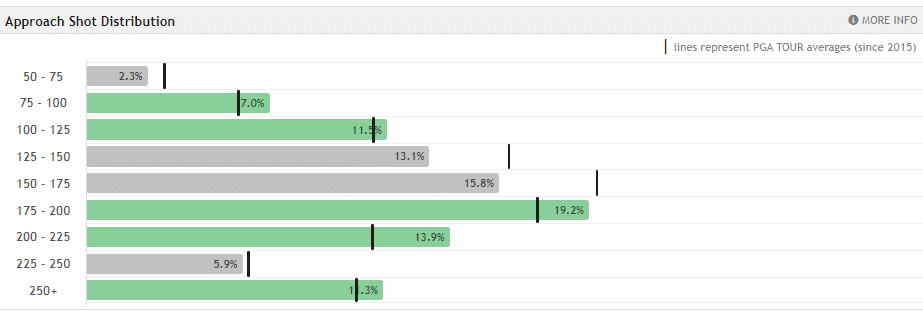
There’s a higher proportion of shots over 175 yards on the PGA Tour schedule than the typical venue. The three Par 5’s are reachable in 2, with the exception of 18 as players won’t try and carry the large water hazards should they have a poor lie in the rough off the tee. And three of the four Par 3’s play over 200 yards. There also are a handful of Par 4’s that play over 475 yards, though players can shorten up the true yardage of the holes by cutting dog legs.
As such, favor players who tend to hit their longer approach shots well at TPC Twin Cities.
Around the Green & Putting
Of the 91 golf courses played on the PGA Tour since 2015, TPC Twin Cities ranks 62nd and 87th, respectively, in degree of difficulty around the green and putting.
Again, as long as players avoid the water on each hole, either converting great looks at birdie on the green or getting up and down for par isn’t all that difficult at TPC Twin Cities. The greens aren’t overly complex and roll very true with the bentgrass composition. And while some of the bunkers can be a little tricky, missing the green in the rough or short grass isn’t challenging either.
For handicapping purposes, there isn’t a ton of break down in this area because of how easy the tournament conditions are in these areas.
Optimal Player Profile
Here are course fit models, per DataGolf, of the types of players that typically do well at TPC Twin Cities.
Course Fit
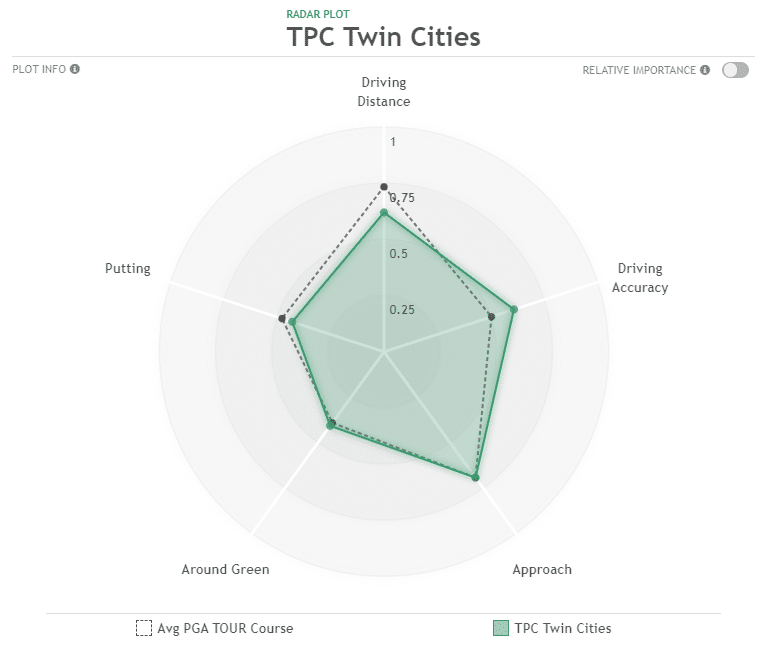
The biggest reveal from this chart is how shorter and accurate players have higher correlations of success at TPC Twin Cities than longer and inaccurate ones. Intuitively, this makes sense. With the primary goal being to avoid water off the tee, players who have an easier time finding fairways have an edge.
And yet, three of the five 3M Open Champions are bombers. And two of them, Cameron Champ and Matthew Wolff, are some of the longest fire hoses in the game. How do we square these inconsistencies? It’s possible that both players are so long that they can take lines off the tee away from the trouble that others simply can’t. I.E. maybe they can carry a bunker that’s miles from the water. Or they’re so long they can take water out of play entirely. As such, it’s very possible for a long and inaccurate player to break this model and come out with a win.
The other big takeaway is there is a lack of correlation of putting as a predictive metric to success at TPC Twin Cities. For starters, the greens are some of the easiest to putt on the PGA Tour. But this also might be skewing a little too heavily towards guys like Tony Finau and Cameron Champ, who annually are some of the worst putters on the PGA Tour but found relative success with it in the weeks they won.
As such, consulting the in-tournament variance charts of how players separate themselves at TPC Twin Cities is probably more helpful than the predictive course fit chart.
In tournament Variance
These two charts are from the 2023 and 2022 3M Opens. And they tell two different stories about how players fared overall in the tournament:
2023
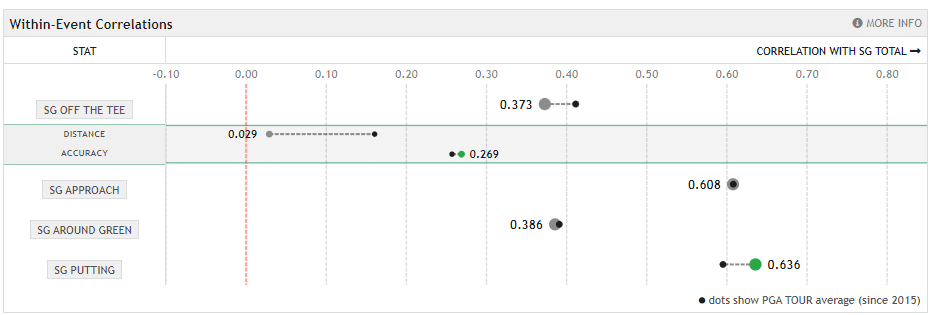
2022
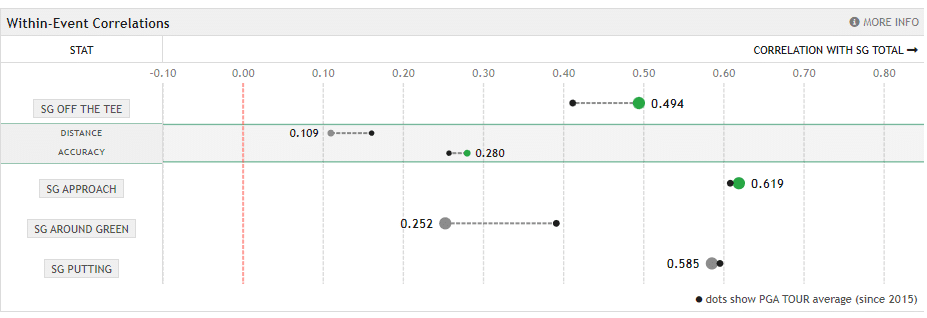
In easy scoring conditions, last year turned into a putting contest. Putting was more impactful towards a players in-tournament strokes gained than the typical PGA Tour setup. And tee-to-green was de-emphasized compared to the typical PGA Tour setup.
Tougher conditions in 2022 elevated better ball-striking. The better in-tournament ball-strikers separated themselves more at TPC Twin Cities than the typical PGA Tour stop. And putting now wasn’t as important towards ones in-tournament strokes gained.
What is consistent, however, is that despite some past champions being big bombers is that in-tournament driving distance isn’t as correlated towards how well one does in SG-Off The Tee than the typical PGA Tour setup. And that was true even in the Cameron Champ victory year. It’ll show up in the ShotLink data if one hits it 311 yards into the water. But that, for obvious reasons, isn’t a good thing for one’s SG-Off The Tee performance.
As such, keep an eye on the weather for this week. The golf course is probably going to be soft from the wet summer most of the northern half of the country has had this year. And if temperatures are hot and there isn’t a lot of wind, expect this to turn into a putting contest like it did in 2023. If not, however, then we may see more of a ball-strikers contest like there was in 2022.

